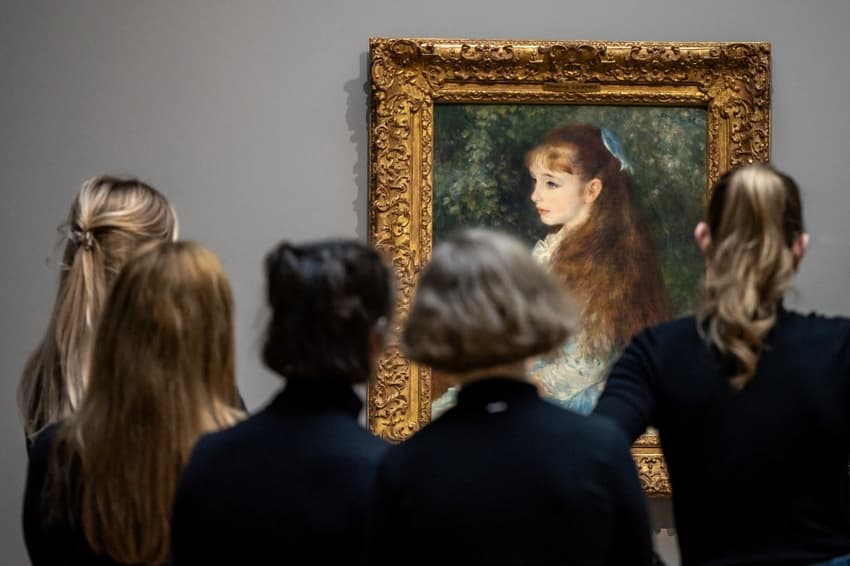Swiss museum reviews collection for Nazi-looted art

Kunsthaus Zurich, one of Switzerland's top art museums, launched a new review on Tuesday aimed at clarifying whether any of its artworks might be cultural property looted by the Nazis.
Ann Demeester, who took over as the museum's director in January, wants to tackle the thorny issue of provenance and art confiscated by Nazi Germany.
The museum said it wanted to see a national independent commission set up to investigate cultural property looted as a result of Nazi persecution.
In the meantime, it said it was setting up its own international commission of independent experts this year.
"Our overriding objective must always be to review professionally the origins of the works we hold," said Philipp Hildebrand, chair of the Zurcher Kunstgesellschaft, the art association which owns the collection and oversees the museum.
"(We must) enable just and fair solutions where there are substantiated indications of cultural property confiscated as a result of Nazi persecution.
"We are aware that this will be a lengthy and complex process," said Hildebrand, a former Swiss central bank chairman.
The museum said it would submit its own collection as well as new acquisitions to the provenance search.
"The provenance of works created prior to 1945 that changed hands between January 1933 and May 1945 will be reviewed," the museum said, referring to the years of Nazi rule in neighbouring Germany.
Demeester, the Belgian former director of the Frans Hals Museum in the Netherlands, said Kunsthaus Zurich had to be proactive and transparent on
provenance research.
"As a museum, we bear a great social responsibility," she said, adding: "Just as important as the research itself is what we do with the results."
The museum faced criticism in 2021 when it opened a new wing to house the collection of arms dealer Emil Buhrle, who made his fortune during World War
II.
The German-born industrialist became a naturalised Swiss citizen in 1937 and died in 1956, having amassed one of Europe's most prestigious private art collections.
The Buhrle Foundation itself confirmed that 13 paintings he bought had been stolen by the Nazis from Jewish owners in France.
Following a series of court cases after World War II, Buhrle in the 1940s returned all 13 pieces to their rightful owners and then repurchased nine of them, the foundation said.
The collection was long displayed at a private museum on the outskirts of Zurich, but it was decided it should be moved following the spectacular 2008 heist of four 19th-century masterpieces.
Comments
See Also
Ann Demeester, who took over as the museum's director in January, wants to tackle the thorny issue of provenance and art confiscated by Nazi Germany.
The museum said it wanted to see a national independent commission set up to investigate cultural property looted as a result of Nazi persecution.
In the meantime, it said it was setting up its own international commission of independent experts this year.
"Our overriding objective must always be to review professionally the origins of the works we hold," said Philipp Hildebrand, chair of the Zurcher Kunstgesellschaft, the art association which owns the collection and oversees the museum.
"(We must) enable just and fair solutions where there are substantiated indications of cultural property confiscated as a result of Nazi persecution.
"We are aware that this will be a lengthy and complex process," said Hildebrand, a former Swiss central bank chairman.
The museum said it would submit its own collection as well as new acquisitions to the provenance search.
"The provenance of works created prior to 1945 that changed hands between January 1933 and May 1945 will be reviewed," the museum said, referring to the years of Nazi rule in neighbouring Germany.
Demeester, the Belgian former director of the Frans Hals Museum in the Netherlands, said Kunsthaus Zurich had to be proactive and transparent on
provenance research.
"As a museum, we bear a great social responsibility," she said, adding: "Just as important as the research itself is what we do with the results."
The museum faced criticism in 2021 when it opened a new wing to house the collection of arms dealer Emil Buhrle, who made his fortune during World War
II.
The German-born industrialist became a naturalised Swiss citizen in 1937 and died in 1956, having amassed one of Europe's most prestigious private art collections.
The Buhrle Foundation itself confirmed that 13 paintings he bought had been stolen by the Nazis from Jewish owners in France.
Following a series of court cases after World War II, Buhrle in the 1940s returned all 13 pieces to their rightful owners and then repurchased nine of them, the foundation said.
The collection was long displayed at a private museum on the outskirts of Zurich, but it was decided it should be moved following the spectacular 2008 heist of four 19th-century masterpieces.
Join the conversation in our comments section below. Share your own views and experience and if you have a question or suggestion for our journalists then email us at [email protected].
Please keep comments civil, constructive and on topic – and make sure to read our terms of use before getting involved.
Please log in here to leave a comment.